Energy Efficiency in Buildings: Toward Climate Neutrality
Abstract
:1. Introduction
2. Climate Neutrality Background
3. Energy Poverty Issue in Households
3.1. The Problem and Determinants of Energy Poverty
- A high proportion of household expenditure spent on energy;
- Low income;
- Low energy performance of buildings and appliances.
3.2. Energy Poverty Indicators
- Energy price index, household expenditure;
- Housing cost overload index;
- At-risk-of-poverty and social exclusion index;
- Unemployment index;
- High cost–low income index.
3.2.1. Household Expenditures—Energy Price Index
3.2.2. Poverty and Social Exclusion Risk Indicator
3.2.3. Unemployment Rate
3.2.4. High Costs–Low Income Indicator
3.3. Possible Solutions to the Problem of Energy Poverty
- -
- Specific heat, which is the simplest and cheapest way of storing both in the form of liquids and solids;
- -
- Phase change energy, using phase change materials (PCMs), which are able to absorb, accumulate, and release energy in the phase change temperature range. During the phase change, significant amounts of heat can be absorbed or released at a practically constant bed temperature;
- -
- Heat of chemical changes—a process that occurs under the influence of a chemical reaction, during which heat can be released (exothermic reactions) or heat must be supplied for its operation (endothermic reactions). The obtained energy is released in an exothermic reaction. An example of this type of reaction is obtaining heat using hydrogen. Energy storage technologies based on the use of phase change materials (PCMs) have gained much attention in the construction sector among architects and engineers over the last four decades [60,61]. PCM materials used for thermal energy storage fill the gap between energy supply and demand by absorbing excess energy in buildings, which makes them a future technology. Currently, the application of PCM materials covers several areas in a wide temperature range from −20 °C to 200 °C for heating, cooling and hybrid systems combining heating and cooling [62].
4. Heat Transfer in HVAC Systems
4.1. Central HVAC Systems
4.2. Local Systems HVAC
4.3. Heat Recovery and Storage in HVAC Systems
4.4. Optimization of HVAC System Operations
5. Energy Efficiency of Buildings
5.1. Energy Consumption in the Buildings Sector
5.2. The Impact of Climate Change on the Energy Efficiency of Buildings
5.3. Analysis of Factors Influencing Energy Consumption in Buildings
- The building’s location relative to the cardinal directions;
- The climate zone in which the building is located;
- The building’s geometry;
- The building materials used in the building’s construction;
- The method of operation and management;
- The parameters of the internal environment;
- The behavior of users;
- The devices.
5.3.1. Weather Conditions
5.3.2. Building Characteristics
5.3.3. Technical Building Systems
- Analysis of the shape of the building and its location (building shape factor);
- Meeting the requirements for thermal insulation of building partitions and glazed surfaces;
- Use of heat gains from sunlight and internal sources;
- Thermal efficiency of heat sources and heating system elements;
- Method of settling heating costs, proper measurement of the installation;
- Tightness of window and door joinery;
- Thermal bridges and tightness of building partitions;
- Type of ventilation;
- Heating systems,
- Cooling systems;
- Energy management and control system in the building;
- Use of renewable energy sources.
5.3.4. User Behavior
5.4. Decarbonisation of Buildings through the Use of Renewable Energy Sources
- From 2027, solar installations must be installed on all new public and non-residential buildings with a usable area of over 250 m2;
- From 2028, they must be installed on all existing non-residential buildings with a usable area of over 500 m2 after major or deeper renovation;
- From 2030, they must be installed on all new residential buildings and covered car parks adjacent to buildings.
6. Modern Trends of the Energy Management in Buildings
7. Conclusions and Directions for Future Research
Author Contributions
Funding
Conflicts of Interest
References
- Towards EU Climate Neutrality Progress, Policy Gaps and Opportunities. European Scientific Advisory Board on Climate Change. Assessment Report 2024, European Scientific Advisory Board on Climate Change, 2024. Available online: https://climate-advisory-board.europa.eu/reports-and-publications/towards-eu-climate-neutrality-progress-policy-gaps-and-opportunities (accessed on 15 July 2024).
- Topics European Parliament. Available online: www.europarl.europa.eu/topics/en/article/20190926STO62270/what-is-carbon-neutrality-and-how-can-it-be-achieved-by-2050 (accessed on 14 March 2024).
- European Concil. Council of the European Union. Available online: https://www.consilium.europa.eu/en/5-facts-eu-climate-neutrality/ (accessed on 14 March 2024).
- Directive (EU) 2023/1791 of THE EUROPEAN PARLIAMENT AND OF THE COUNCIL of 13 September 2023 on Energy Efficiency and Amending Regulation (EU) 2023/955. Available online: https://eur-lex.europa.eu/legal-content/EN/TXT/?uri=OJ%3AJOL_2023_231_R_0001&qid=1695186598766 (accessed on 13 March 2024).
- Directive 2010/31/EU of The European Parliament and of the Council of 19 May 2010 on the Energy Performance of Buildings. Available online: https://eur-lex.europa.eu/legal-content/EN/TXT/?uri=CELEX%3A02010L0031-20210101 (accessed on 13 March 2024).
- Directive 2008/50/EC of the European Parliament and of the Council of 21 May 2008 on ambient air quality and cleaner air for Europe. Off. J. Eur. Union 2008, 29, 169–212.
- National Aeronautics and Space Administration Goddard Institute for Space Studies. Available online: https://data.giss.nasa.gov/ (accessed on 14 May 2024).
- Scripps Institution of Oceanography at UC San Diego. Available online: https://keelingcurve.ucsd.edu/ (accessed on 14 May 2024).
- Laurikka, H. The impact of climate policy on heat and power capacity investment decisions. In Emissions Trading and Business; Antes, R., Hansjürgens, B., Letmathe, P., Eds.; Springer: Berlin/Heidelberg, Germany, 2006. [Google Scholar] [CrossRef]
- Energy, Climate change, Environment, The European Union. Available online: https://climate.ec.europa.eu/climate-change/causes-climate-change_en (accessed on 15 July 2024).
- Liu, L.; He, G.; Wu, M.; Liu, G.; Zhang, H.; Chen, Y.; Shen, J.; Li, S. Climate change impacts on planned supply–demand match in global wind and solar energy systems. Nat. Energy 2023, 8, 870–880. [Google Scholar] [CrossRef]
- International Energy Agency, World Energy Outlook 2023. Available online: www.iea.org (accessed on 14 May 2024).
- BP Energy Outlook 2023 & 2024 Edition. Available online: https://www.bp.com/en/global/corporate/energy-economics/energy-outlook.html (accessed on 15 July 2024).
- Chen, L.; Msigwa, G.; Yang, M.; Osman, A.I.; Fawzy, S.; Rooney, D.W.; Yap, S. Strategies to achieve a carbon neutral society: A review. Environ. Chem. Lett. 2022, 20, 2277–2310. [Google Scholar] [CrossRef]
- Liu, Z.; Deng, Z.; Davis, S.J.; Ciais, P. Global carbon emissions in 2023. Nat. Rev. Earth Environ. 2024, 5, 253–254. [Google Scholar] [CrossRef]
- Nocoń, A. Towards climate neutrality in mining and energy companies in Poland—An approach to their financing. Miner. Resour. Manag. 2022, 38, 69–89. [Google Scholar] [CrossRef]
- Eurostat Statistics Exlpained. Energy Statistics—An Overview. Available online: https://ec.europa.eu/eurostat/statistics-explained/index.php?title=Energy_statistics_-_an_overview#Final_energy_consumption (accessed on 6 September 2024).
- Wang, Y.; Wang, R.; Tanaka, K.; Ciais, P.; Penuelas, J.; Balkanski, Y.; Sardans, J.; Hauglustaine, D.; Liu, W.; Xing, X.; et al. Accelerating the energy transition towards photovoltaic and wind in China. Nature 2023, 619, 761–767. [Google Scholar] [CrossRef]
- Krause, J.; Yugo, M.; Samaras, Z.; Edwards, S.; Fontaras, G.; Dauphin, R.; Prenninger, P.; Neugebauer, S. Well-to-wheels scenarios for 2050 carbon-neutral road transport in the EU. J. Clean. Prod. 2024, 443, 141084. [Google Scholar] [CrossRef]
- Shirizadeh, B.; Ailleret, A.; Cartry, C.; Douguet, S.; Gehring, T.; Maden, S.; Mais, B.; Mross, L.; Theis, J.; Cabot, C.; et al. Climate neutrality in European heavy-duty road transport: How to decarbonise trucks and buses in less than 30 years? Energy Convers. Manag. 2024, 309, 118438. [Google Scholar] [CrossRef]
- Bhakta, S.; Kundu, B.A. Review of Thermoelectric Generators in Automobile Waste Heat Recovery Systems for Improving Energy Utilization. Energies 2024, 17, 1016. [Google Scholar] [CrossRef]
- Wang, Q.; Fan, J.; Kwan, M.P.; Zhou, K.; Shen, G.; Li, N.; Wu, B.; Lin, J. Examining energy inequality under the rapid residential energy transition in China through household surveys. Nat. Energy 2023, 8, 251–263. [Google Scholar] [CrossRef]
- PN-EN 12831:2017; Heating Installations in Buildings. Method of Calculating the Design Heat Load. Polish Committee for Standardization: Warsaw, Poland, 2017.
- PN-EN ISO 14683:2017-09; Thermal Bridges in Building Construction—Linear Thermal Transmittance—Simplified Methods and Default Values. International Organization for Standardization: Geneva, Switzerland, 2017.
- PN-EN ISO 52016-1:2017; Energy Performance of Buildings-Energy Demand for Heating and Cooling, Internal Temperatures and Sensible and Latent Heat Loads-Part 1: Calculation Procedures. International Organization for Standardization: Geneva, Switzerland, 2017.
- PN-EN ISO 6946:2017-10; Building Components and Building Elements—Thermal Resistance and Thermal Transmittance—Calculation Methods. International Organization for Standardization: Geneva, Switzerland, 2017.
- Cengel, Y.A. Heat Transfer. In A Practical Approach, 2nd ed.; McGraw-Hill Science/Engineering/Math: New York, NY, USA, 2002. [Google Scholar]
- Babiarz, B.; Szymański, W. Introduction to the Dynamics of Heat Transfer in Buildings. Energies 2020, 13, 6469. [Google Scholar] [CrossRef]
- Regulation of the Minister of Infrastructure of April 12, 2002, on the Technical Conditions to Be Met by Buildings and Their Location (In Polish). Journal of Laws No. 75, Item 690, as Amended. Available online: https://sip.lex.pl/akty-prawne/dzu-dziennik-ustaw/warunki-techniczne-jakim-powinny-odpowiadac-budynki-i-ich-usytuowanie-16964625 (accessed on 15 July 2024).
- Regulation of the Minister of Infrastructure and Development of 27 February 2015 on the methodology for determining the energy performance of a building or part of a building and energy performance certificates (In Polish). Journal of Laws of 18 March 2015, item 376, as Amended. Available online: https://isap.sejm.gov.pl/isap.nsf/DocDetails.xsp?id=WDU20150000376 (accessed on 15 July 2024).
- Sarbu, I.; Dorca, A. Review on heat transfer analysis in thermal energy storage using latent heat storage systems and phase change materials. Int. J. Energy Res. 2019, 43, 29–64. [Google Scholar] [CrossRef]
- Yu, R.; Manjavacas, A.; García de Abajo, F.J. Ultrafast radiative heat transfer. Nat. Commun. 2017, 8, 2. [Google Scholar] [CrossRef]
- Basok, B.; Davydenko, B.; Pavlenko, A.; Novikov, V.; Novitska, M. The influence of geometric characteristics of the buildings facades on the heat transfer to the wind flow. J. New Technol. Environ. Sci. 2021, 5, 1–50. [Google Scholar]
- Jezierski, W.; Sadowska, B.; Pawłowski, K. Impact of Changes in the Required Thermal Insulation of Building Envelope on Energy Demand, Heating Costs, Emissions, and Temperature in Buildings. Energies 2021, 14, 56. [Google Scholar] [CrossRef]
- Dylewski, R. Optimal Thermal Insulation Thicknesses of External Walls Based on Economic and Ecological Heating Cost. Energies 2019, 12, 3415. [Google Scholar] [CrossRef]
- Xue, Y.; Ge, Z.; Du, X.; Yang, L. On the Heat Transfer Enhancement of Plate Fin Heat Exchanger. Energies 2018, 11, 1398. [Google Scholar] [CrossRef]
- Emmel, M.G.; Abadie, M.O.; Mendes, N. New external convective heat transfer coefficient correlations for isolated low-rise buildings. Energy Build. 2007, 39, 335–342. [Google Scholar] [CrossRef]
- Clarke, J.A. Energy Simulation in Building Design; Butterworth-Heinemann: Oxford, UK, 2001. [Google Scholar]
- Gerlich, V. Modelling of Heat Transfer in Buildings. In Proceedings of the 25th Conference on Modelling and Simulation, Krakow, Poland, 7–10 June 2011. [Google Scholar] [CrossRef]
- Simões, N.; Prata, J.; Tadeu, A. 3D Dynamic Simulation of Heat Conduction through a Building Corner Using a BEM Model in the Frequency Domain. Energies 2019, 12, 4595. [Google Scholar] [CrossRef]
- Act of 10 April 1997 on the Energy Law. Available online: www.ure.gov.pl/download.php?s=2&id=2 (accessed on 2 October 2018).
- Wierzbiński, M. Management aspects of the district heating systems’ transformation towards climate neutrality. In Accounting and Business in a Sustainable Post-Covid World: New Perspectives and Challenges; Dyczkowska, J., Ed.; Publishing House of Wroclaw University of Economics and Business: Wroclaw, Poland, 2022; pp. 136–163. [Google Scholar] [CrossRef]
- Babiarz, B. Aspects of Heat Supply Security Management Using Elements of Decision Theory. Energies 2018, 11, 2764. [Google Scholar] [CrossRef]
- To, L.S.; Bruce, A.; Munro, P.; Santagata, E.; MacGill, I.; Rawali, M.; Raturi, A. A research and innovation agenda for energy resilience in Pacific Island Countries and Territories. Nat. Energy 2021, 6, 1098–1103. [Google Scholar] [CrossRef]
- Future-Proofing Energy Systems: The Energy Resiliency Framework (ARUP, 2019). Available online: https://www.arup.com/energy-resilience-framework (accessed on 15 July 2024).
- Tychanicz-Kwiecień, M.; Grosicki, S. Research methods in the study of heat transfer coefficient during flow in minichannels. J. Mech. Energy Eng. 2021, 5, 59–68. [Google Scholar] [CrossRef]
- Bergles, A.E. Techniques to enhance heat transfer. In Handbook of Heat Transfer, 3rd ed.; McGraw-Hill: New York, NY, USA, 1998; Volume 11, pp. 1–11, 76. [Google Scholar]
- Mousavi Ajarostaghi, S.S.; Zaboli, M.; Javadi, H.; Badenes, B.; Urchueguia, J.F. A Review of Recent Passive Heat Transfer Enhancement Methods. Energies 2022, 15, 986. [Google Scholar] [CrossRef]
- DIRECTIVE 2009/72/EC OF THE EUROPEAN PARLIAMENT AND OF THE COUNCIL of 13 July 2009 concerning common rules for the internal market in electricity and repealing Directive 2003/54/EC. Available online: https://eur-lex.europa.eu/legal-content/EN/ALL/?uri=celex%3A32009L0072 (accessed on 15 July 2024).
- Energy, Climate Change, Environment. Energy Poverty. Available online: https://energy.ec.europa.eu/topics/markets-and-consumers/energy-consumers-and-prosumers/energy-poverty_en?prefLang=pl (accessed on 14 August 2024).
- Electricity Prices for Household Consumers-bi-Annual Data (from 2007 Onwards). Available online: https://ec.europa.eu/eurostat/databrowser/view/nrg_pc_204/default/table?lang=en&fbclid=IwAR2Xh0ofim1iAz7lP-uhxMbC_UvOlpxVhV0hikFvh328cWRg5zc69olZ0Nw (accessed on 14 August 2024).
- Electricity Prices for Non-Household Consumers- bi-Annual Data (from 2007 Onwards). Available online: https://ec.europa.eu/eurostat/databrowser/view/nrg_pc_205/default/table?lang=en&fbclid=IwAR275HJW27_oNv226us5JcnLvzFjmg2ZYdozIe5MQx2uqAAfKOef7iFAprI (accessed on 14 August 2024).
- Housing Cost Overburden Rate by Tenure Status-EU-SILC Survey. Available online: https://ec.europa.eu/eurostat/databrowser/view/ilc_lvho07c/default/table?lang=en&fbclid=IwAR1xjf9Po5UUrwXNV48jYc1fYszqsLJbzVZ_QXn1o3QaqfP_XZl4YpP0Rzg (accessed on 14 August 2024).
- People at Risk of Poverty or Social Exclusion. Available online: https://ec.europa.eu/eurostat/databrowser/view/tipslc10/default/table?lang=en&fbclid=IwAR0SrEK5ecUp6nF4XbHpqmKNj483oOdbxRJob36F_fFgugoC5AFUzNTsUeY (accessed on 14 August 2024).
- Unemployment Rate-Annual Data. Available online: https://ec.europa.eu/eurostat/databrowser/view/tipsun20/default/table?lang=en&fbclid=IwAR0usNomJak3HugLKpPWtWVfi3dPgocUmhA41TyxBaTT7Eqti6txAcGXldM (accessed on 14 August 2024).
- Sokołowski, J.; Frankowski, J.; Lewandowski, P. Energy Poverty, Housing Conditions, and Self-Assessed Health: Evidence from Poland. IBS Working Paper 10/2020, December 2020. Available online: https://ibs.org.pl/publications/ubostwo-energetyczne-warunki-mieszkaniowe-i-zdrowie-w-polsce/ (accessed on 14 August 2024).
- Sałach, K.; Lewandowski, P. Energy Poverty Measurement Based on Public Health Data—Methodology and Application. Available online: https://ibs.org.pl/app/uploads/2018/02/IBS_Research_Report_pl_01_2018.pdf (accessed on 20 August 2024). (In Polish).
- Faraj, K.; Khaled, M.; Faraj, J.; Hachem, F.; Castelain, C. Phase change material thermal energy storage systems for cooling applications in buildings: A review. Renew. Sustain. Energy Rev. 2020, 119, 109579. [Google Scholar] [CrossRef]
- Dincer, I.; Erdemir, D. Chapter 2-Heat Storage Methods. In Heat Storage Systems for Buildings; Elsevier: Amsterdam, The Netherlands, 2021; pp. 37–90. [Google Scholar] [CrossRef]
- Maccarini, A.; Hultmark, G.; Bergsoe, N.; Afshari, A. Free cooling potential of a PCM-based heat exchanger coupled with a novel HVAC system for simultaneous heating and cooling of buildings. Sustain. Cities Soc. 2018, 42, 384–395. [Google Scholar] [CrossRef]
- Boussamba, L.; Foufa, A.; Makhlouf, S.; Lefebrve, G.; Royon, L. Elaboration and properties of a composite bio-based PCM for an application in building envelopes. Constr. Build. Mater. 2018, 185, 156–165. [Google Scholar] [CrossRef]
- Du, K.; Calautit, J.; Wang, Z.; Wu, Y.; Liu, H. A review of the applications of phase change materials in cooling, heating and power generation in different temperature ranges. Appl. Energy 2018, 220, 242–273. [Google Scholar] [CrossRef]
- Marincu, C.; Dan, D.; Mogą, L. Investigating the influence of building shape and insulation thickness on energy efficiency of buildings. Energy Sustain. Dev. 2024, 79, 101384. [Google Scholar] [CrossRef]
- Wang, Y.; Liu, K.; Liu, Y.; Wang, D.; Liu, J. The impact of temperature and relative humidity dependent thermal conductivity of insulation materials on heat transfer through the building envelope. J. Build. Eng. 2022, 46, 103700. [Google Scholar] [CrossRef]
- Wang, D.; Hu, L.; Du, H.; Liu, Y.; Huang, J.; Xu, Y.; Liu, J. Classification, experimental assessment, modeling methods and evaluation metrics of Trombe walls. Renew. Sustain. Energy Rev. 2020, 124, 1097725. [Google Scholar] [CrossRef]
- Żelazna, A.; Lichołai, L.; Krasoń, J.; Miąsik, P.; Mikušová, D. The Effects of Using a TrombeWall Modified with a phase Change Material, from the Perspective of a Building’s Life Cycle. Energies 2023, 16, 7689. [Google Scholar] [CrossRef]
- Starakiewicz, A.; Miasik, P.; Krason, J.; Babiarz, B. Multi-Aspect Shaping of the Building’s Heat Balance. Energies 2024, 17, 2702. [Google Scholar] [CrossRef]
- Marani, A.; Nehdi, M.L. Integrating phase change materials in construction materials: Critical review. Constr. Build. Mater. 2019, 217, 36–49. [Google Scholar] [CrossRef]
- Wang, X.; Li, W.; Luo, Z.; Wang, K.; Shah, S.P. A critical review on phase change materials (PCM) for sustainable and energy efficient building: Design, characteristic, performance and application. Energy Build. 2022, 260, 111923. [Google Scholar] [CrossRef]
- Xu, X.; Xie, J.; Zhang, X.; Gao, S.; Cao, Y.; Liu, J. Optimal selection of window components in China based on energy performance modeling. Energy Build. 2023, 297, 113400. [Google Scholar] [CrossRef]
- Shen, Y.; Xue, P.; Luo, T.; Zhang, Y.; Tso, C.Y.; Zhang, N.; Sun, Y.; Xie, J.; Liu, J. Regional applicability of thermochromic windows based on dynamic radiation spectrum. Renew. Energy 2022, 196, 15–27. [Google Scholar] [CrossRef]
- Zomorodian, S.Z.; Tahsildoost, M.; Hafezi, M. Thermal comfort in educational buildings: A review article. Renew. Sustain. Energy Rev. 2016, 59, 895–906. [Google Scholar] [CrossRef]
- Ala’raj, M.; Radi, M.; Abbod, M.F.; Majdalawieh, M.; Parodi, M. Data-driven based HVAC optimisation approaches: A Systematic Literature Review. J. Build. Eng. 2022, 46, 103678. [Google Scholar] [CrossRef]
- Hidalgo-Le´on, R.; Litardo, J.; Urquizo, J.; Moreira, D.; Singh, P.; Soriano, G. Some factors involved in the improvement of building energy consumption: A brief review. In Proceedings of the 2019 IEEE Fourth Ecuador Technical Chapters Meeting (ETCM), Guayaquil, Ecuador, 13–15 November 2019; pp. 1–6. [Google Scholar] [CrossRef]
- Seyam, S. Types of HVAC Systems; IntechOpen: London, UK, 2018; pp. 49–66. [Google Scholar] [CrossRef]
- Hooshamand, S.M.; Zhang, H.; Javidanfar, H.; Zhai, Y.; Wagner, A. A review of local radiant heating systems and their effects on thermal comfort and sensation. Energy Build. 2023, 296, 113331. [Google Scholar] [CrossRef]
- Amanowicz, Ł. Influence of geometrical parameters on the flow characteristics of multi-pipe earth-to-air heat exchangers–experimental and CFD investigations. Appl. Energy 2018, 226, 849–861. [Google Scholar] [CrossRef]
- Amanowicz, Ł.; Ratajczak, K. Stosowanie odzysku ciepła, OZE oraz zdecentralizowanych systemów wentylacyjnych w kontekście wymagań WT 2021. Rynek Instal. 2021, 7–8. [Google Scholar]
- Turski, M.; Sekret, R. Buildings and a district heating network as thermal energy storages in the district heating system. Energy Build. 2018, 179, 49–56. [Google Scholar] [CrossRef]
- Dec, E.; Sekret, R.; Babiarz, B. Possibilities of using solar energy in the processes of cooling external zones of people. E3S Web Conf. 2018, 49, 16. [Google Scholar] [CrossRef]
- Sekret, R.; Starzec, P.; Kotowicz, J. Research on water–ice heat accumulator and analysis of its potential use as hybrid source heat pump for building heating. Energy Build. 2023, 300, 113670. [Google Scholar] [CrossRef]
- Kim, Y.; Lee, J.S.; Jeon, S.W. 12-Hybrid ground-source heat pump systems. In Advances in Ground-Source Heat Pump Systems; Woodhead Publishing: Sawston, UK, 2016; pp. 331–357. [Google Scholar] [CrossRef]
- Du, Y.F.; Jiang, L.; Duan, C.; Li, Y.Z.; Smith, J.S. Energy Consumption Scheduling of HVAC Considering Weather Forecast Error Through the Distributionally Robust Approach. IEEE Trans. Ind. Inform. 2018, 14, 846–857. [Google Scholar] [CrossRef]
- Ochs, F.; Franzoi, N.; Dermentzis, G.; Monteleone, W.; Magni, M. Monitoring and simulation-based optimization of two multi-apartment NZEBs with heat pump, solar thermal and PV. J. Build. Perform. Simul. 2024, 17, 1–26. [Google Scholar] [CrossRef]
- EP-PE_TC1-COD(2021)0426, POSITION OF THE EUROPEAN PARLIAMENT Adopted at First Reading on 12 March 2024 with a View to the Adoption of Directive (EU) 2024/… of the European Parliament and of the Council on the Energy Performance of Buildings (Recast). Available online: https://www.europarl.europa.eu/doceo/document/TC1-COD-2021-0426_EN.pdf (accessed on 15 July 2024).
- Filippidou, F.; Jimenez Navarro, J.P. Achieving the Cost-Effective Energy Transformation of Europe’s Buildings; Energy Renovations via Combinations of Insulation and Heating & Cooling Technologies Methods and Data, JRC Technical Report; Publications Office of the European Union: Luxembourg, 2019. [Google Scholar] [CrossRef]
- Nishimwe, A.M.R.; Reiter, S. Using artificial intelligence models and degree-days method to estimate the heat consumption evolution of a building stock until 2050: A case study in a temperate climate of the Northern part of Europe. Clean. Responsible Consum. 2022, 5, 100069. [Google Scholar] [CrossRef]
- COM/2020/662 Final. Communication from the Commission to the European Parliament, the Council, the European Economic and Social Committee and the Committee of the Regions, A Renovation Wave for Europe-Greening Our Buildings, Creating Jobs, Improving Lives; Brussels, 14 October 2020. Available online: https://eur-lex.europa.eu/legal-content/en/ALL/?uri=CELEX:52020DC0662 (accessed on 15 July 2024).
- Chen, S.; Zhang, G.; Xia, X.; Setunge, S.; Shi, L. A review of internal and external influencing factors on energy efficiency design of buildings. Energy Build. 2020, 216, 109944. [Google Scholar] [CrossRef]
- Billio, M.; Casarin, R.; Costola, M.; Veggente, V. Learning from experts: Energy efficiency in residential buildings. Energy Econ. 2024, 136, 107650. [Google Scholar] [CrossRef]
- Available online: https://www.eceee.org/all-news/news/news-2023/epbd-recast-must-define-deep-renovation-as-the-standard-bpie-study/ (accessed on 28 February 2023).
- Galvin, R. Policy pressure to retrofit Germany’s residential buildings to higher energy efficiency standards: A cost-effective way to reduce CO2 emissions? Build. Environ. 2023, 237, 110316. [Google Scholar] [CrossRef]
- World Energy Outlook 2023, International Energy Agency. Available online: https://iea.blob.core.windows.net/assets/86ede39e-4436-42d7-ba2a-edf61467e070/WorldEnergyOutlook2023.pdf (accessed on 15 July 2024).
- Available online: https://ec.europa.eu/eurostat/statistics-explained/index.php?title=Energy_consumption_in_households (accessed on 15 July 2024).
- Rahif, R.; Norouziasas, A.; Elnagar, E.; Doutreloup, S.; Pourkiaei, S.M.; Amaripadath, D.; Romain, A.C.; Fettweis, X.; Attia, S. Impact of climate change on nearly zero-energy dwelling in temperate climate: Time-integrated discomfort, HVAC energy performance, and GHG emissions. Build. Environ. 2022, 223, 109397. [Google Scholar] [CrossRef]
- Carvalho, A.D.; Mendrinos, D.; De Almeida, A.T. Ground source heat pump carbon emissions and primary energy reduction potential for heating in buildings in Europe—Results of a case study in Portugal. Renew. Sustain. Energy Rev. 2015, 45, 755–768. [Google Scholar] [CrossRef]
- Su, Y.; Jin, Q.; Zhang, S.; He, S. A review on the energy in buildings: Current research focus and future development direction. Heliyon 2024, 10, e32869. [Google Scholar] [CrossRef] [PubMed]
- Lin, Y.; Zhao, L.; Yang, W.; Hao, X.; Li, C.-Q. A review on research and development of passive building in China. J. Build. Eng. 2021, 42, 102509. [Google Scholar] [CrossRef]
- Kirmea, S.K.; Vijay SKapseb, A. Comprehensive Review of Residential Building Energy Efficiency Measures in India. Energy Build. 2024; in press. [Google Scholar] [CrossRef]
- Okonta, D.E. Investigating the impact of building materials on energy efficiency and indoor cooling in Nigerian homes. Heliyon 2023, 9, e20316. [Google Scholar] [CrossRef]
- Cholewa, T.; Balaras, C.A.; Kurnitski, J.; Mazzarella, L.; Siuta-Olcha, A.; Dascalaki, E.; Kosonen, R.; Lungu, C.; Todorovic, M.; Nastase, I.; et al. Energy Efficient Renovation of Existing Buildings for HVAC Professionals; Federation of European Heating, Ventilation and Air Conditioning Associations (REHVA): Brussels, Belgium, 2022; ISBN 978-2-930521-31-2. [Google Scholar]
- Zeyen, E.; Hagenmeyer, V.; Brown, T. Mitigating heat demand peaks in buildings in a highly renewable European energy system. Energy 2021, 231, 120784. [Google Scholar] [CrossRef]
- Bayer, P.; Saner, D.; Bolay, S.; Rybach, L.; Blum, P. Greenhouse gas emission savings of ground source heat pump systems in Europe: A review. Renew. Sustain. Energy Rev. 2012, 16, 1256–1267. [Google Scholar] [CrossRef]
- Jafarpur, P.; Berardi, U. Effects of climate changes on building energy demand and thermal comfort in Canadian office buildings adopting different temperature setpoints. Build. Eng. 2021, 42, 102725. [Google Scholar] [CrossRef]
- Kotharkar, R.; Ghosh, A.; Kapoor, S.; Reddy, D.G.K. Approach to local climate zone based energy consumption assessment in an Indian city. Energy Build. 2022, 259, 111835. [Google Scholar] [CrossRef]
- Frank, T. Climate change impacts on building heating and cooling energy demand in Switzerland. Energy Build. 2005, 37, 1175–1185. [Google Scholar] [CrossRef]
- Berger, T.; Amann Ch Formayer, H.; Korjenic, A.; Pospischal, B.; Neururer, C.; Smutny, R. Impacts of climate change upon cooling and heating energy demand of office buildings in Vienna, Austria. Energy Build. 2014, 80, 517–530. [Google Scholar] [CrossRef]
- Żurawski, J. Optymalizacja Energetyczna Istniejących Budynków do Poziomu nZEB, Rynek Instalacyjny, 4, 2018. Available online: https://www.izolacje.com.pl/artykul/sciany-stropy/183186,optymalizacja-energetyczna-istniejacych-budynkow-do-poziomu-nzeb (accessed on 15 July 2024). (In Polish).
- Li, L.; Sun, W.; Hu, W.; Sun, Y. Impact of natural and social environmental factors on building energy consumption: Based on bibliometrics. J. Build. Eng. 2021, 37, 102136. [Google Scholar] [CrossRef]
- Liu, D.; Wang, W.; Liu, J. Sensitivity Analysis of Meteorological Parameters on Building Energy Consumption. Energy Procedia 2017, 132, 634–639. [Google Scholar] [CrossRef]
- De Rosa, M.; Bianco, V.; Scarpa, F.; Tagliafico, L.A. Heating and cooling building energy demand evaluation; a simplified model and a modified degree days approach. Appl. Energy 2014, 128, 217–229. [Google Scholar] [CrossRef]
- Andrić, I.; Gomes, N.; Pina, A.; Ferrão, P.; Fournier, J.; Lacarrière, B.; Le Corre, O. Modeling the long-term effect of climate change on building heat demand: Case study on a district level. Energy Build. 2016, 126, 77–93. [Google Scholar] [CrossRef]
- Gadd, H.; Werner, S. Daily heat load variations in Swedish district heating systems. Appl. Energy 2013, 106, 47–55. [Google Scholar] [CrossRef]
- Ochedi, E.T.; Taki, A. A framework approach to the design of energy efficient residential buildings in Nigeria. Energy Built Environ. 2022, 3, 384–397. [Google Scholar] [CrossRef]
- Bosu, I.; Mahmoud, H.; Ookawara, S.; Hassan, H. Applied single and hybrid solar energy techniques for building energy consumption and thermal comfort: A comprehensive review. Sol. Energy 2023, 259, 188–228. [Google Scholar] [CrossRef]
- Soares Geraldi, M.; Martins Gnecco, V.; Neto, A.B.; de Mafra Martins, B.A.; Ghisi, E.; Fossati, M.; Melo, A.P.; Lamberts, R. Evaluating the impact of the shape of school reference buildings on bottom-up energy benchmarking. J. Build. Eng. 2021, 43, 103142. [Google Scholar] [CrossRef]
- Premrov, M.; Žegarac Leskovar, V.; Mihalič, K. Influence of the building shape on the energy performance of timber-glass buildings in different climatic conditions. Energy 2016, 108, 201–211. [Google Scholar] [CrossRef]
- Nowak, Ł. The Impact of the Building Envelope on Its Energy Performance, Energy-Active Architecture after 2021 Volume 1; Architectural and Construction Issues. 2020, pp. 75–94. Available online: https://www.google.com/url?sa=t&source=web&rct=j&opi=89978449&url=https://dbc.wroc.pl/Content/78366/ae2021_tom2_LQ.pdf&ved=2ahUKEwjv6_uax86IAxXVSPEDHc5TCy4QFnoECBwQAQ&usg=AOvVaw3DxYTPiDxgAjR5j3IHezgx (accessed on 15 July 2024). (In Polish).
- Tuhus-Dubrow, D.; Krarti, M. Genetic-algorithm based approach to optimize building envelope design for residential buildings. Build. Environ. 2010, 45, 1574–1581. [Google Scholar] [CrossRef]
- Pacheco, R.; Ordonez, J.; Martinez, G. Energy efficient design of building: A review. Renew. Sustain. Energy Rev. 2012, 16, 3559–3573. [Google Scholar] [CrossRef]
- Directive (EU) 2024/1275 of the European Parliament and of the Council of 24 April 2024 on the Energy Performance of Buildings (Recast) (Text with EEA Relevance); Official Journal of the European Union PE/102/2023/REV/1, Document 32024L1275. Available online: https://eur-lex.europa.eu/legal-content/EN/TXT/?uri=CELEX%3A32024L1275 (accessed on 15 July 2024).
- Cholewa, T.; Siuta-Olcha, A. Long term experimental evaluation of the influence of heat cost allocators on energy consumption in a multifamily building. Energy Build. 2015, 104, 122–130. [Google Scholar] [CrossRef]
- Canale, L.; Dell’Isola, M.; Ficco, G.; Cholewa, T.; Siggelsten, S.; Balen, I. A comprehensive review on heat accounting and cost allocation in residential buildings in EU. Energy Build. 2019, 202, 109398. [Google Scholar] [CrossRef]
- Cholewa, T.; Siuta-Olcha, A.; Balaras, C.A. Actual energy savings from the use of thermostatic radiator valves in residential buildings–Long term field evaluation. Energy Build. 2017, 151, 487–493. [Google Scholar] [CrossRef]
- Cholewa, T.; Balen, I.; Siuta-Olcha, A. On the influence of local and zonal hydraulic balancing of heating system on energy savings in existing buildings–Long term experimental research. Energy Build. 2018, 179, 156–164. [Google Scholar] [CrossRef]
- Cholewa, T.; Siuta-Olcha, A.; Anasiewicz, R. On the possibilities to increase energy efficiency of domestic hot water preparation systems in exist-ing buildings–Long term field research. J. Clean. Prod. 2019, 217, 194–203. [Google Scholar] [CrossRef]
- Bocian, M.; Siuta-Olcha, A.; Cholewa, T. On the circulation heat losses in domestic hot water systems in residential buildings. Energy Sustain. Dev. 2022, 71, 406–418. [Google Scholar] [CrossRef]
- Siuta-Olcha, A.; Cholewa, T.; Gomółka, M.; Kołodziej, P.; Østergaard, D.S.; Svendsen, S. On the influence of decommissioning an area thermal substation in a district heating system on heat consumption and costs in buildings–Long term field research. Sustain. Energy Technol. Assess. 2022, 50, 101870. [Google Scholar] [CrossRef]
- Chen, S.; Zhang, G.; Xia, X.; Chen, Y.; Shi, L. The impacts of occupant behavior on building energy consumption: A review. Sustain. Energy Technol. Assess. 2021, 45, 101212. [Google Scholar] [CrossRef]
- Li, D.; Menassa, C.C.; Karatas, A. Energy use behaviors in buildings: Towards an integrated conceptual framework. Energy Res. Soc. Sci. 2017, 23, 97–112. [Google Scholar] [CrossRef]
- Yu, Z.; Haghighat, F.; Fung, B.C.M.; Morofsky, E.; Yoshino, H. A methodology for identifying and improving occupant behavior in residential buildings. Energy 2011, 36, 6596–6608. [Google Scholar] [CrossRef]
- Terés-Zubiaga, J.; Pérez-Iribarren, E.; González-Pino, I.; Sala, J.M. Effects of individual metering and charging of heating and domestic hot water on energy consumption of buildings in temperate climates. Energy Convers. Manag. 2018, 171, 491–506. [Google Scholar] [CrossRef]
- Abrahamse, W.; Steg, L.; Vlek, C.; Rothengatter, T. A review of intervention studies aimed at household energy conservation. J. Environ. Psychol. 2005, 25, 273–291. [Google Scholar] [CrossRef]
- Gullev, L.; Poulsen, M. The installation of meters leads to permanent changes in consumer behaviour. News DBDH 2006, 3, 20–24. [Google Scholar]
- Narula, K.; Ploiner, C.; Getzinger, G.; Patel, M.K. Impact of energy efficiency and decarbonisation policies for buildings: A comparative assessment of Austria and Switzerland. Energy Build. 2022, 268, 112175. [Google Scholar] [CrossRef]
- Love, J.; Smith, A.Z.P.; Watson, S.; Oikonomou, E.; Summerfield, A.; Gleeson, C.; Biddulph, P.; Chiu, L.F.; Wingfield, J.; Martin, C.; et al. The addition of heat pump electricity load profiles to GB electricity demand: Evidence from a heat pump field trial. Appl. Energy 2017, 204, 332–342. [Google Scholar] [CrossRef]
- William, M.A.; Suárez-López, M.J.; Soutullo, S.; Fouad, M.M.; Hanafy, A.A. Enviro-economic assessment of buildings decarbonization scenarios in hot climates: Mindset toward energy-efficiency. Energy Rep. 2022, 8 (Suppl. 10), 172–181. [Google Scholar] [CrossRef]
- Omer, A.M. Ground-source heat pumps systems and applications. Renew. Sustain. Energy Rev. 2008, 12, 344–371. [Google Scholar] [CrossRef]
- Haines, A.; Smith, K.; Anderson, D.; Epstein, P.; McMichael, A.; Roberts, P.; Wilkinson, P.; Woodcock, J.; Woods, J. Policies for accelerating access to clean energy, improving health, advancing development, and mitigating climate change. Lancet 2021, 370, 1264–1281. [Google Scholar] [CrossRef]
- Wang, X.; Xia, L.; Bales, C.; Zhang, X.; Copertaro, B.; Pan, S.; Wu, J. A systematic review of recent air source heat pump (ASHP) systems assisted by solar thermal, photovoltaic and photovoltaic/thermal sources. Renew. Energy 2020, 146, 2472–2487. [Google Scholar] [CrossRef]
- Abbasi, M.H.; Abdullah, B.; Ahmed, M.W.; Rostami, A.; Cullen, J. Heat transition in the European building sector: Overview of the heat decarbonisation practices through heat pump technology. Sustain. Energy Technol. Assess. 2021, 48, 101630. [Google Scholar] [CrossRef]
- Lin, H.; Clavreul, J.; Jeandaux, C.; Crawley, J.; Butnar, I. Environmental life cycle assessment of heating systems in the UK: Comparative assessment of hybrid heat pumps vs. condensing gas boilers. Energy Build. 2021, 240, 110865. [Google Scholar] [CrossRef]
- Joniec, W. Elektryfikacja ciepłownictwa, Technologie wytwarzania ciepła i ich integracja z systemem energetycznym. Rynek Instal. 2021, 4, 2021344079. [Google Scholar]
- Saini, P.; Paolo, B.; Fiedler, F.; Widén, J.; Zhang, X. Techno-economic analysis of an exhaust air heat pump system assisted by unglazed transpired solar collectors in a Swedish residential cluster. Sol. Energy 2021, 224, 966–983. [Google Scholar] [CrossRef]
- Maruf, N.; Morales-España, G.; Sijm, J.; Helistö, N.; Kiviluoma, J. Classification, potential role, and modeling of power-to-heat and thermal energy storage in energy systems: A review. Sustain. Energy Technol. Assess. 2022, 53 Part B, 102553. [Google Scholar] [CrossRef]
- Cassarino, T.G.; Barrett, M. Meeting UK heat demands in zero emission renewable energy systems using storage and interconnectors. Appl. Energy 2022, 306, 118051. [Google Scholar] [CrossRef]
- Zhang, Y.; Johansson, P.; Kalagasidis, A.S. Techno-economic assessment of thermal energy storage technologies for demand-side management in low-temperature individual heating systems. Energy 2021, 236, 121496. [Google Scholar] [CrossRef]
- Yang, T.; Liu, W.; Kramer, G.J.; Sun, Q. Seasonal thermal energy storage: A techno-economic literature review. Renew. Sustain. Energy Rev. 2021, 139, 110732. [Google Scholar] [CrossRef]
- Guelba, E.; Verda, V. Thermal energy storage in district heating and cooling systems: A review. Appl. Energy 2019, 252, 113474. [Google Scholar] [CrossRef]
- Barns, D.G.; Taylor, P.G.; Bale, C.S.E.; Owen, A. Important social and technical factors shaping the prospects for thermal energy storage. J. Energy Storage 2021, 41, 102877. [Google Scholar] [CrossRef]
- Krawczyk, D.A.; Sadowska, B. Buildings 2020+. In Constructions, Materials and Installations; Printing House of Bialystok University of Technology: Bialystok, Poland, 2019; p. 246. ISBN 978-83-65596-70-3. [Google Scholar] [CrossRef]
- Renganayagalu, S.; Bodal, T.; Bryntesen, T.R. Optimising Energy Performance of buildings through Digital Twins and Machine Learning: Lessons learnt and future directions. In Proceedings of the 2024 4th International Conference on Applied Artificial Intelligence (ICAPAI), Halden, Norway, 16 April 2024. [Google Scholar] [CrossRef]
- Jamil, H.; Jian, Y.; Jamil, F.; Hijjawi, M.; Muthanna, A. Digital twin-driven architecture for AIoT-based energy service provision and optimal energy trading between smart nanogrids. Energy Build. 2024, 319, 114463. [Google Scholar] [CrossRef]
- Alavi, H.; Forcada, N.; Fan, S.L.; San, W. BIM-based augmented reality for facility maintenance management. In Proceedings of the European Conference on Computing in Construction, Rhodes, Greece, 19–28 July 2021; Volume 2, pp. 431–438. [Google Scholar] [CrossRef]
- Cespedes-Cubides, A.S.; Jradi, M. A review of building digital twins to improve energy efficiency in the building operational stage. Energy Inform. 2024, 7, 11. [Google Scholar] [CrossRef]
- Agouzoul, A.; Tabaa, M.; Chegari, B.; Simeu, E.; Dandache, A.; Alami, K. Towards a Digital Twin model for Building Energy Management: Case of Morocco. Procedia Comput. Sci. 2021, 184, 404–410. [Google Scholar] [CrossRef]
- IBM, What Is a Digital Twin? Available online: https://www.ibm.com/topics/what-is-a-digital-twin (accessed on 4 September 2024).
- Olcott, S.; Mullen, C. Digital Twin Consortium Defines Digital Twin. Available online: https://www.digitaltwinconsortium.org/2020/12/digital-twin-consortium-defines-digital-twin/ (accessed on 4 September 2024).
- Yu, W.; Patros, P.; Young, B.; Klinac, E.; Walmsey, T.G. Energy digital twin technology for industrial energy management: Classification, challenges and future. Renew. Sustain. Energy Rev. 2022, 161, 112407. [Google Scholar] [CrossRef]
- Budiardjo, A. The Impact of Digital Twins on Smart Buildings. Available online: https://www.digitaltwinconsortium.org/2021/01/the-impact-of-digital-twins-on-smart-buildings/ (accessed on 15 July 2024).
- Wang, W.; Guo, H.; Li, X.; Tang, S.; Xia, J.; Lv, Z. Deep learning for assessment of environment al satisfaction using BIM big data in energy efficient building digital twins. Sustain. Energy Technol. Assess. 2022, 50, 101897. [Google Scholar] [CrossRef]
- Chen, K.; Zhu, X.; Anduv, B.; Jin, X.; Du, Z. Digital twins model and its updating method for heating, ventilation and air conditioning system using broad learning system algorithm. Energy 2022, 251, 124040. [Google Scholar] [CrossRef]
- ARUP. The EU Green Deal and Building Retrofits: Making It Work for Everyone. Available online: https://www.arup.com/perspectives/the-eu-green-deal-and-retrofits-making-it-work-for-everyone (accessed on 4 September 2024).
- Jradi, M.; Madsen, B.E.; Kaiser, J.H. DanRETwin: A Digital Twin Solution for Optimal Energy Retrofit Decision-Making and Decarbonization of the Danish Building Stock. Appl. Sci. 2023, 13, 9778. [Google Scholar] [CrossRef]
- Kannari, L.; Piira, K.; Vainio, T.; Biström, H. Energy-data-related digital twin for office building and data centre complex. In Proceedings of the 37th Conference on Design of Circuits and Integrated Circuits (DCIS), Pamplona, Spain, 16–18 November 2022. [Google Scholar] [CrossRef]
- Petri, I.; Rezgui, Y.; Ghoroghi, A.; Alzahrani, A. Digital twins for performance management in the built environment. J. Ind. Inf. Integr. 2023, 33, 100445. [Google Scholar] [CrossRef]
- Merino, S.; Guzmán, F.; Döllner, J.; Martínez, J.; Guzmán, R.; de Dios Lara, J. Towards Concepts for Climate and Energy-Oriented Digital Twins for Buildings. In Proceedings of the 28th International ACM Conference on 3D Web Technology, San Sebastian, Spain, 9–11 October 2023. [Google Scholar] [CrossRef]
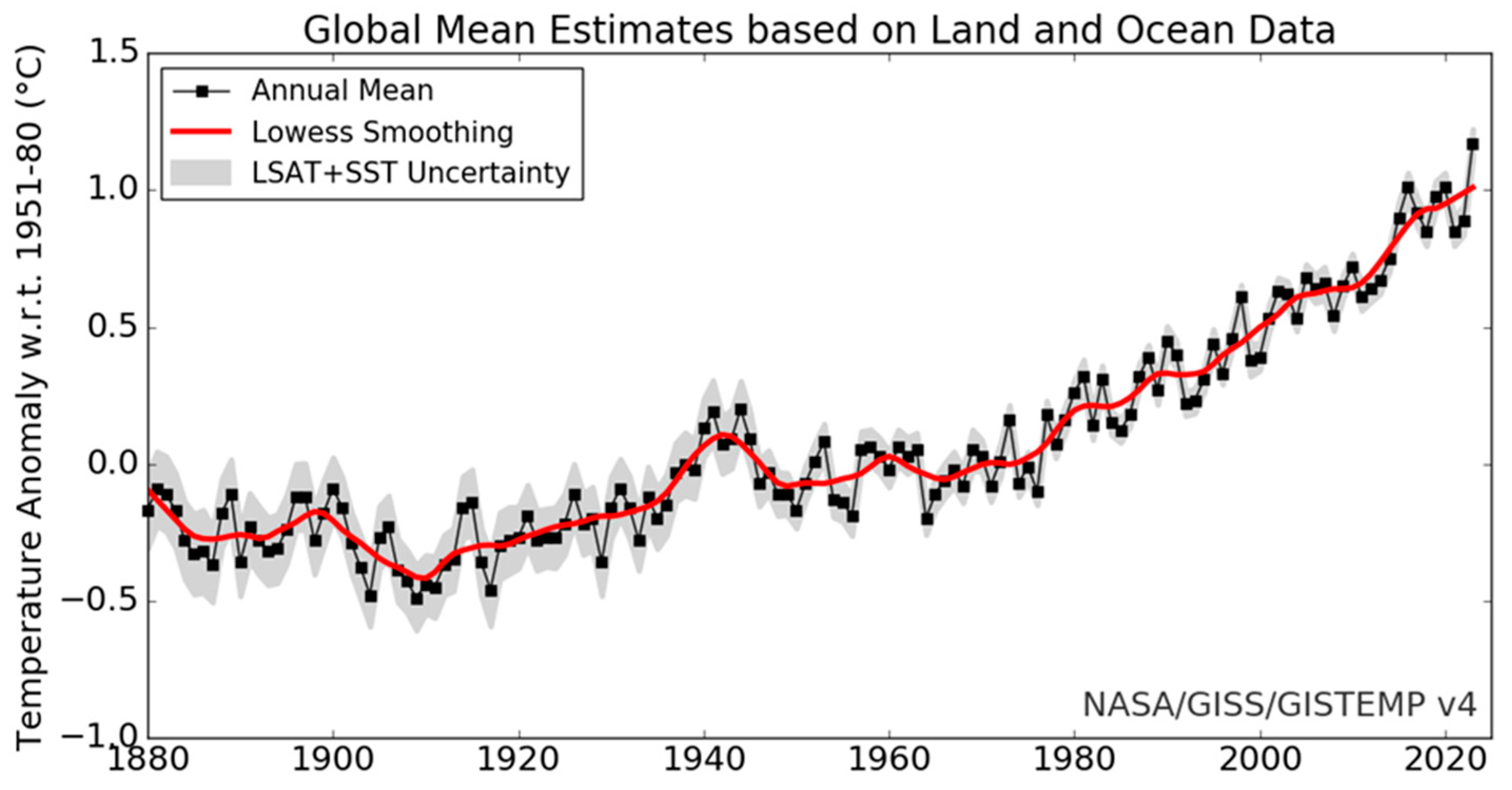

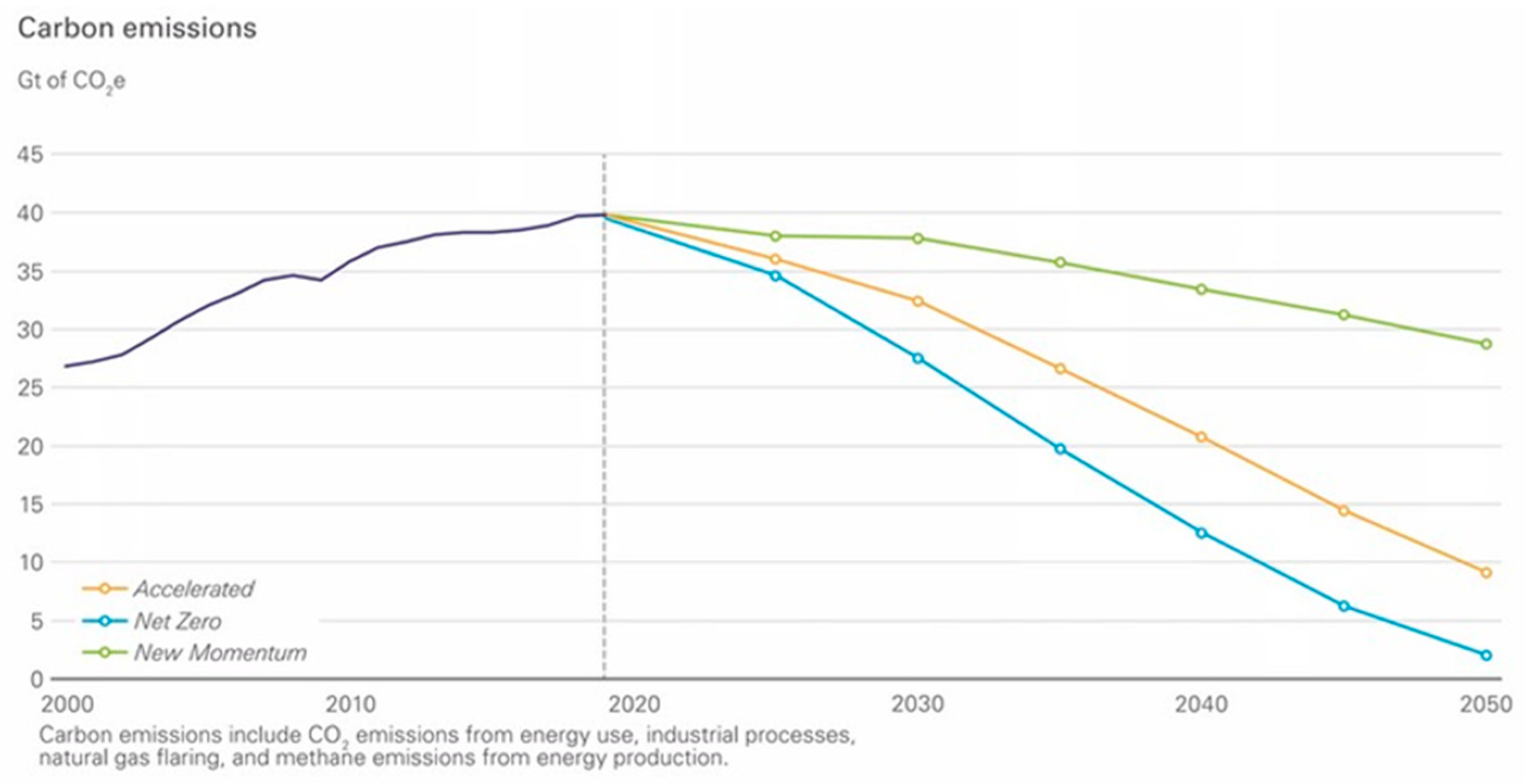
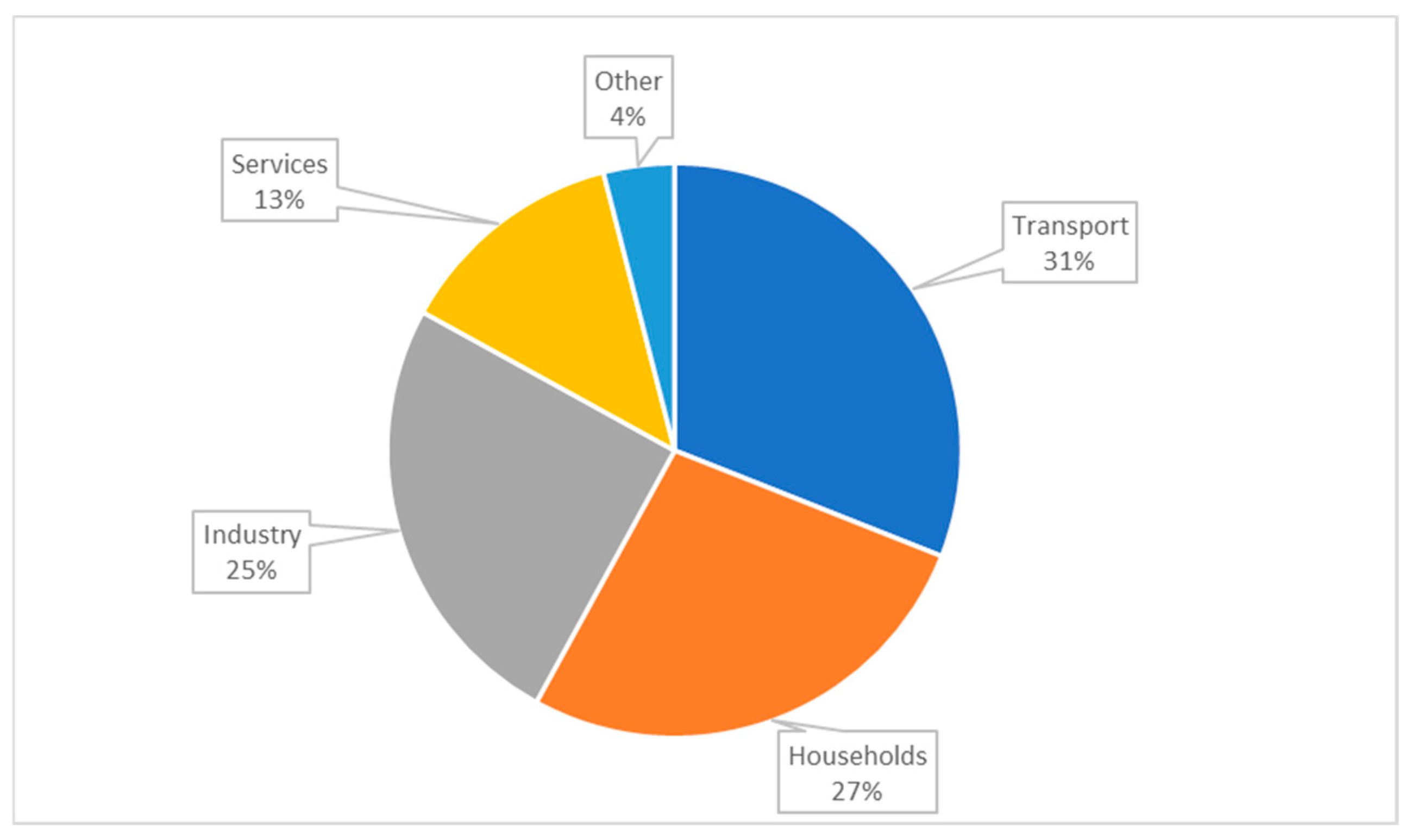



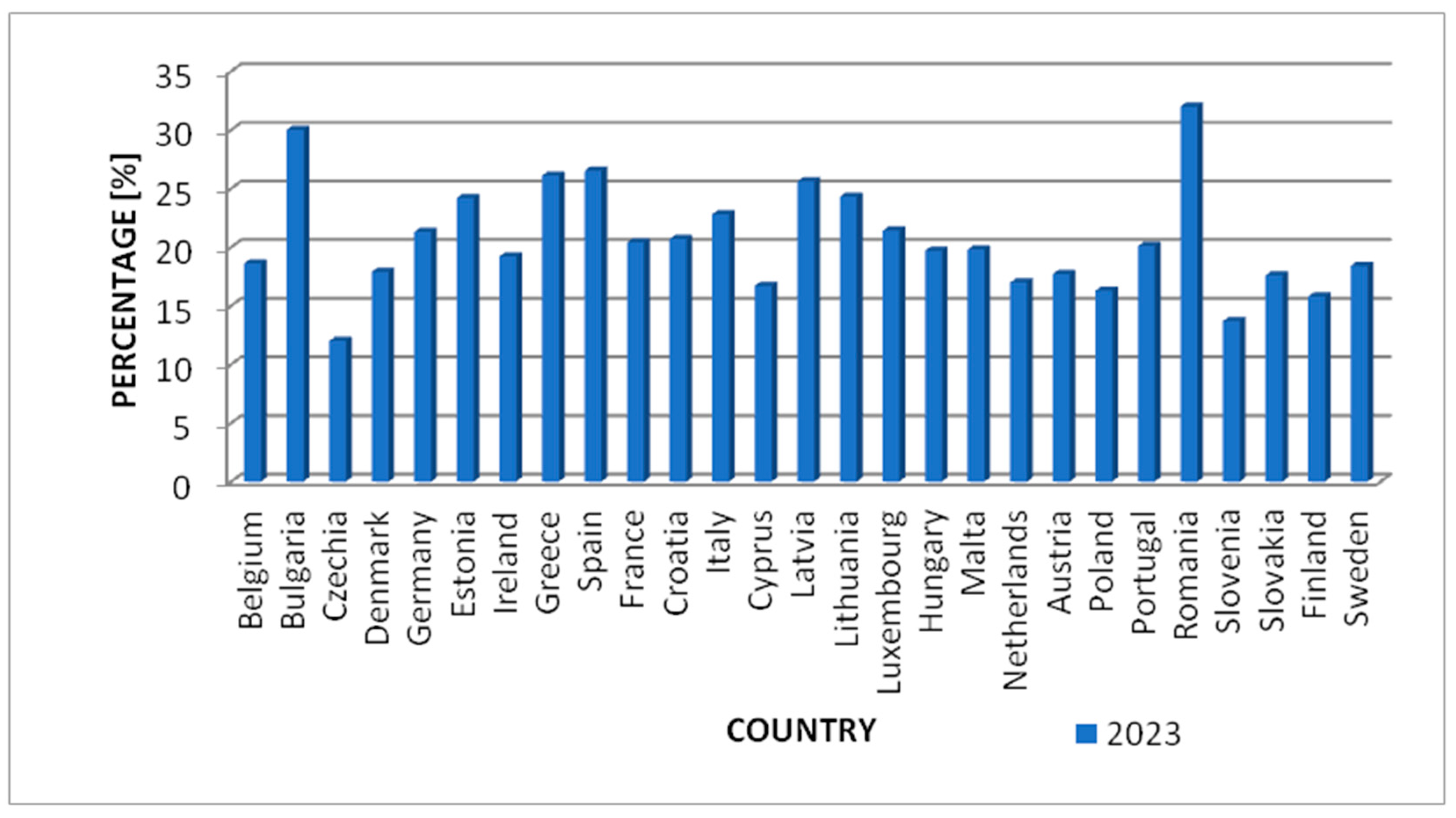
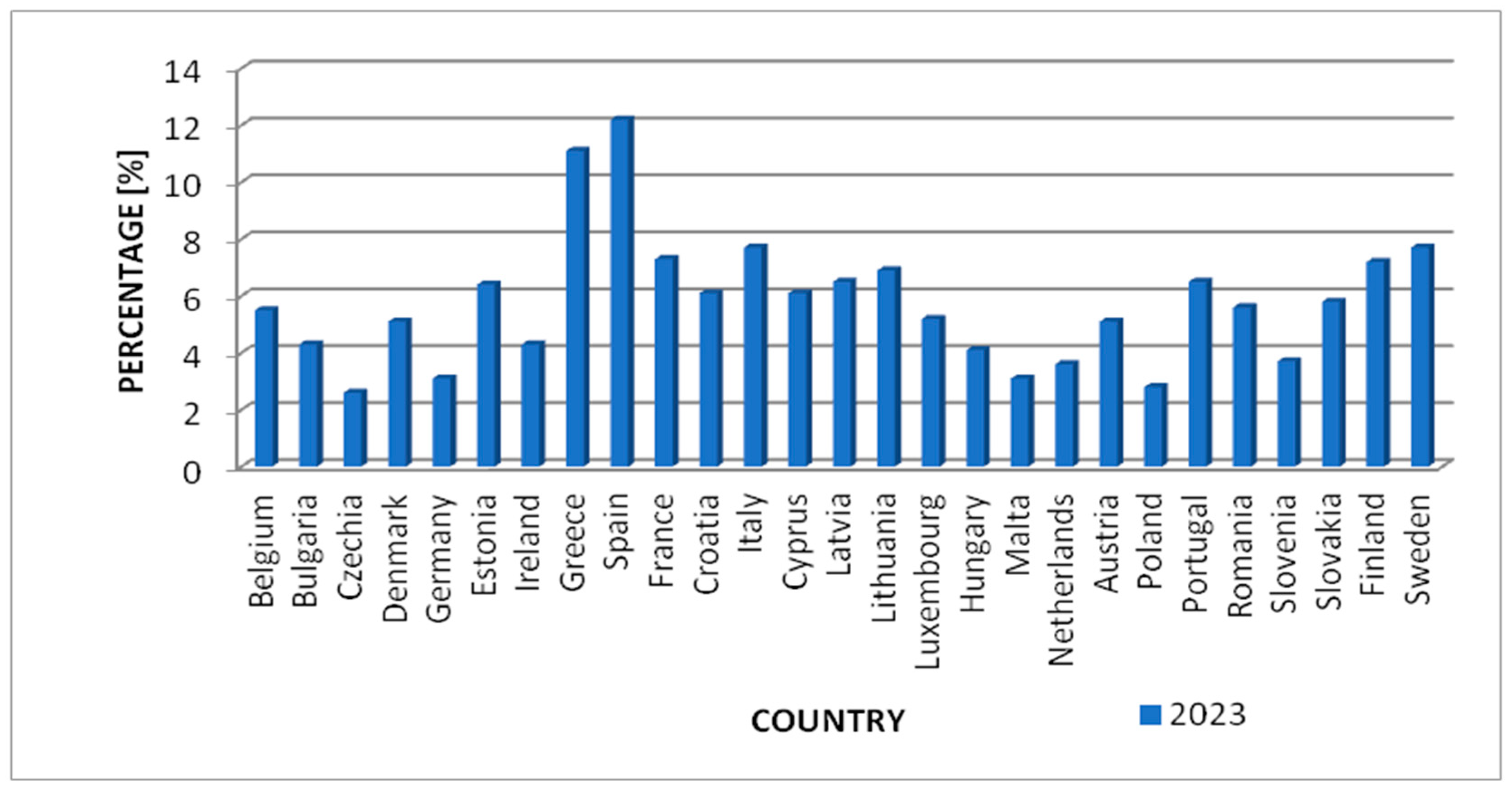

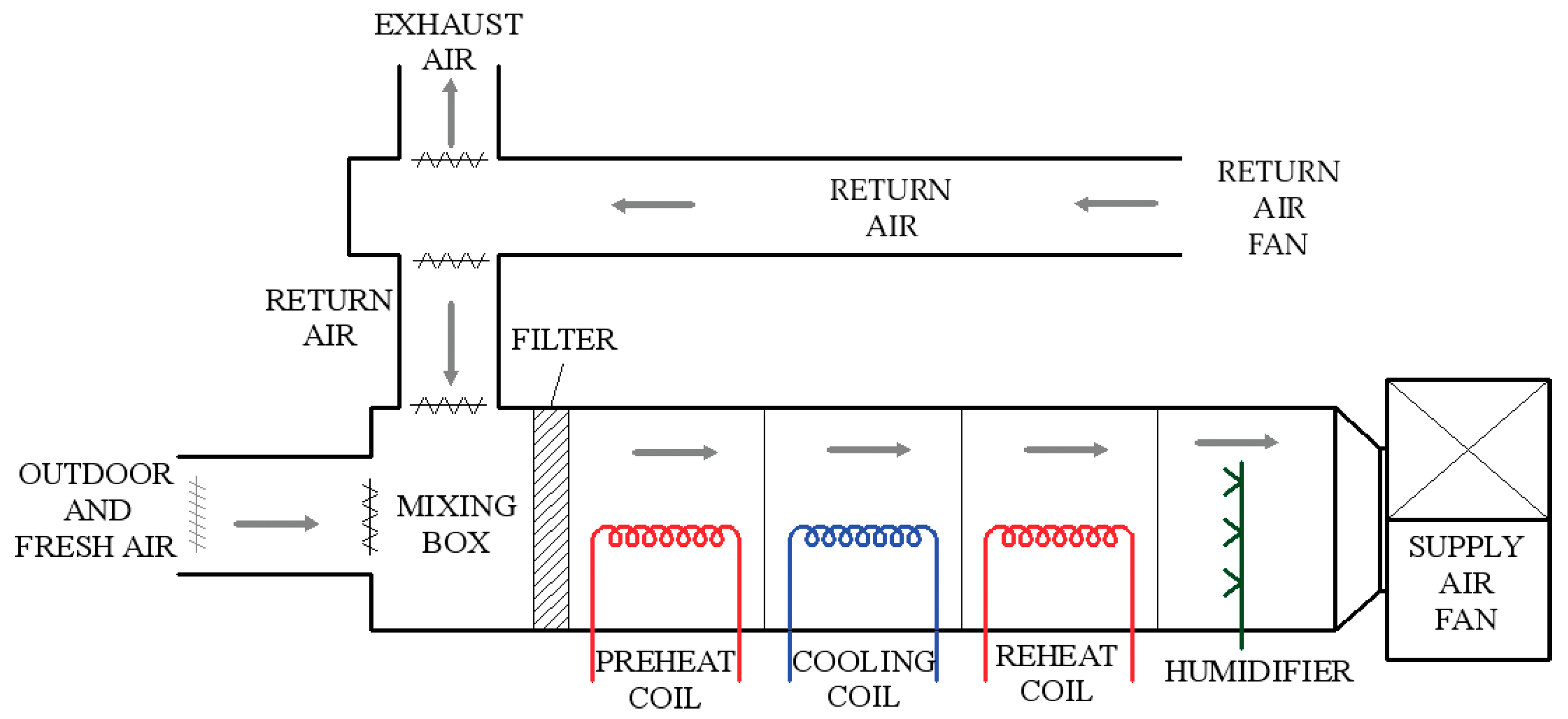
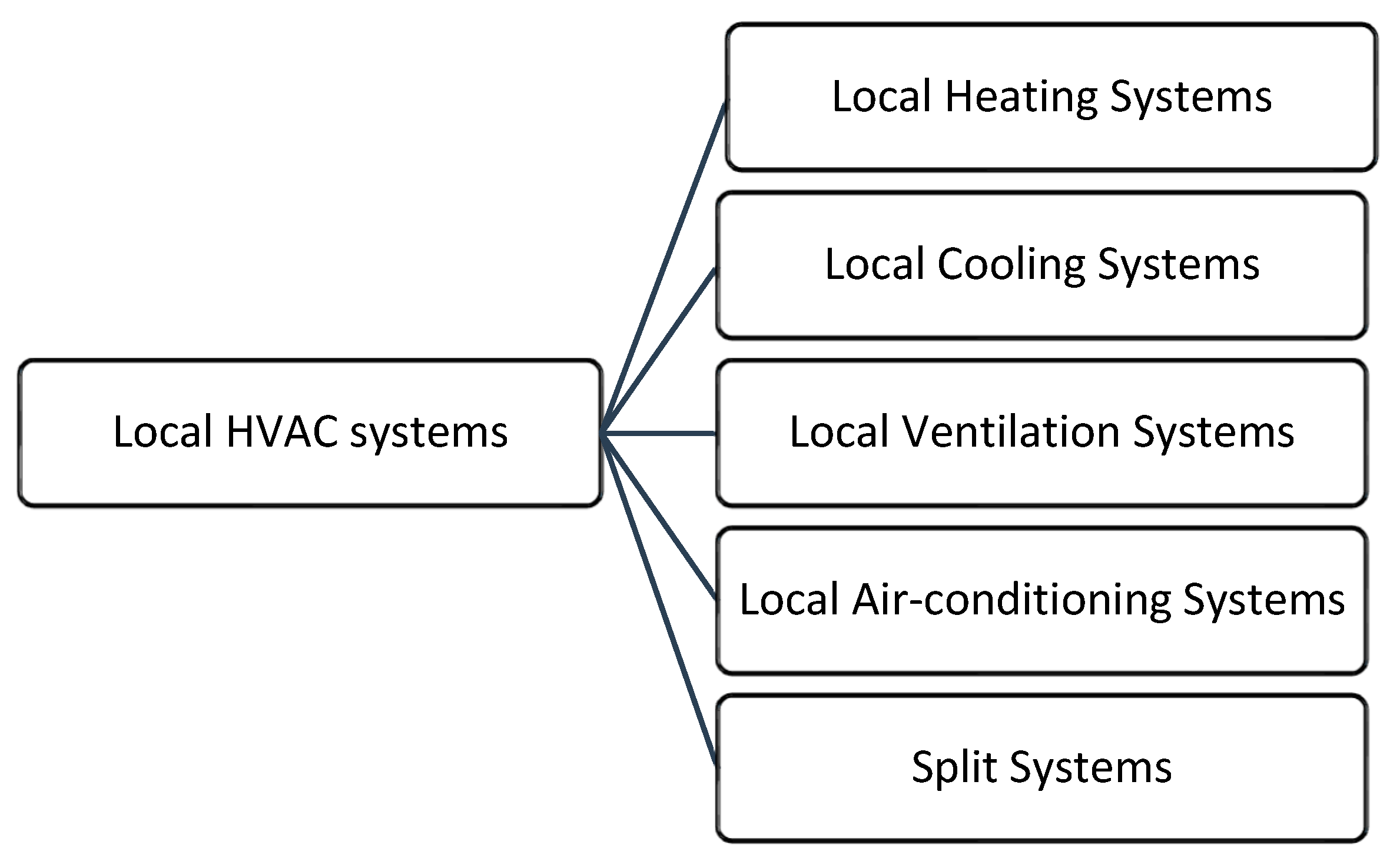

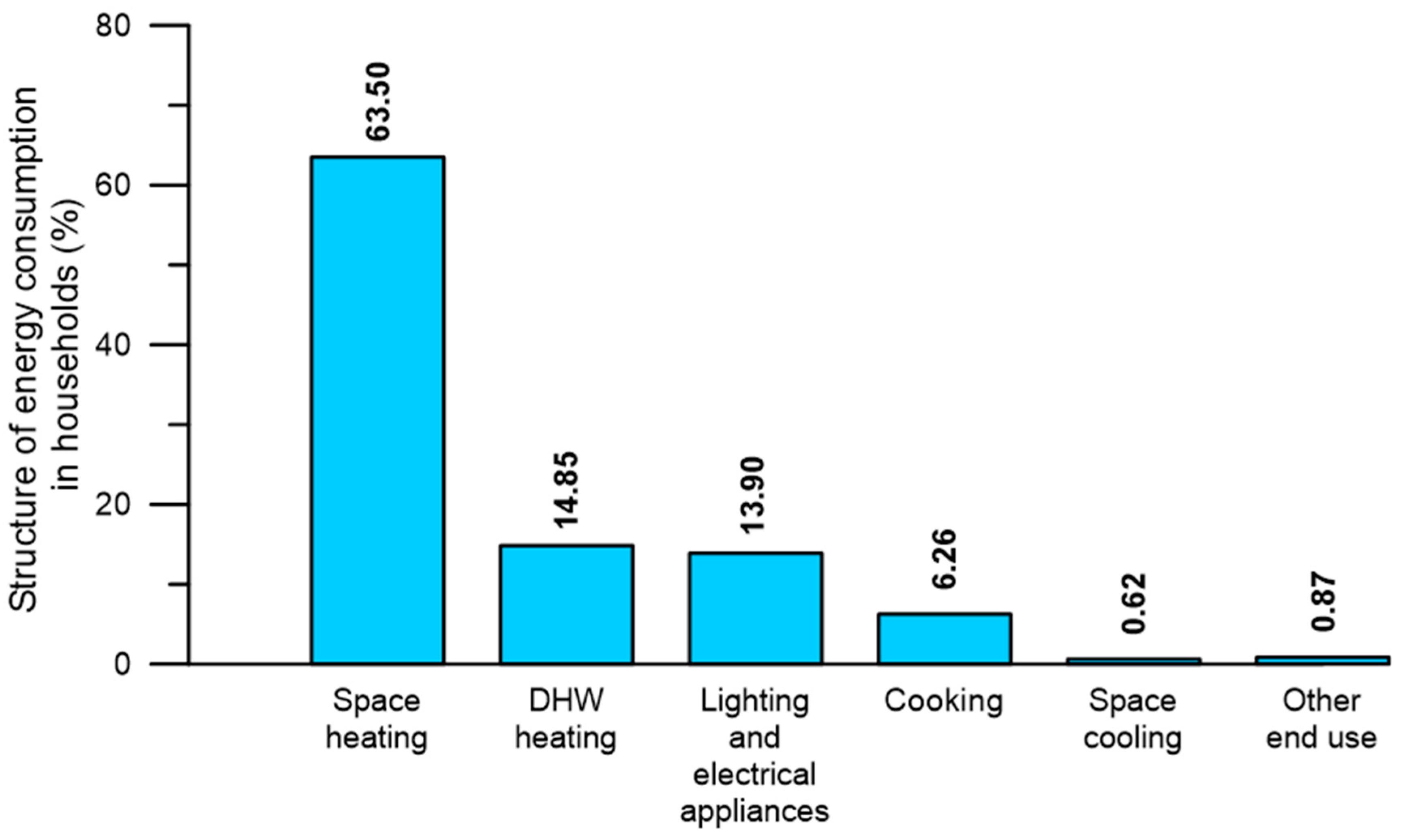

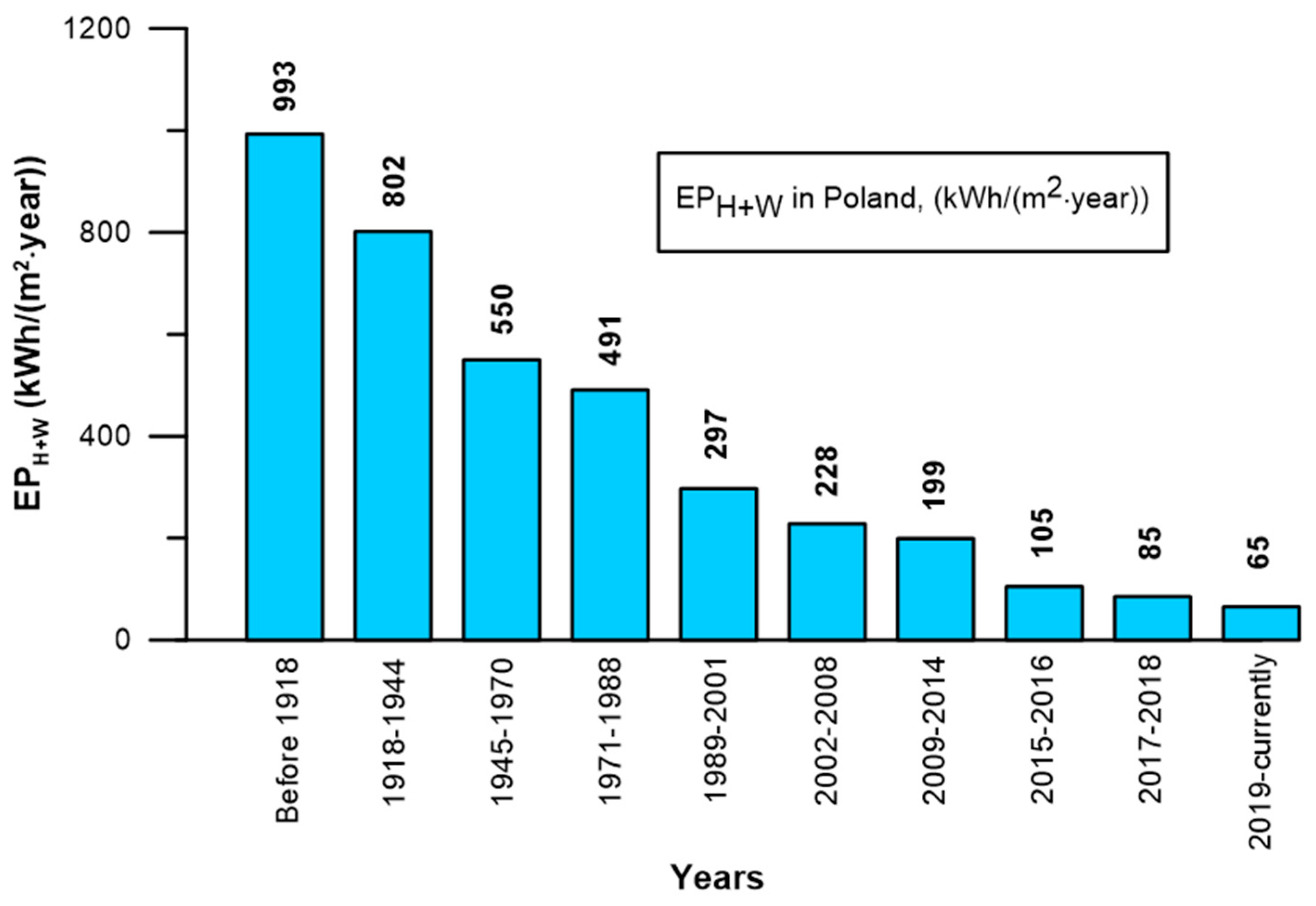

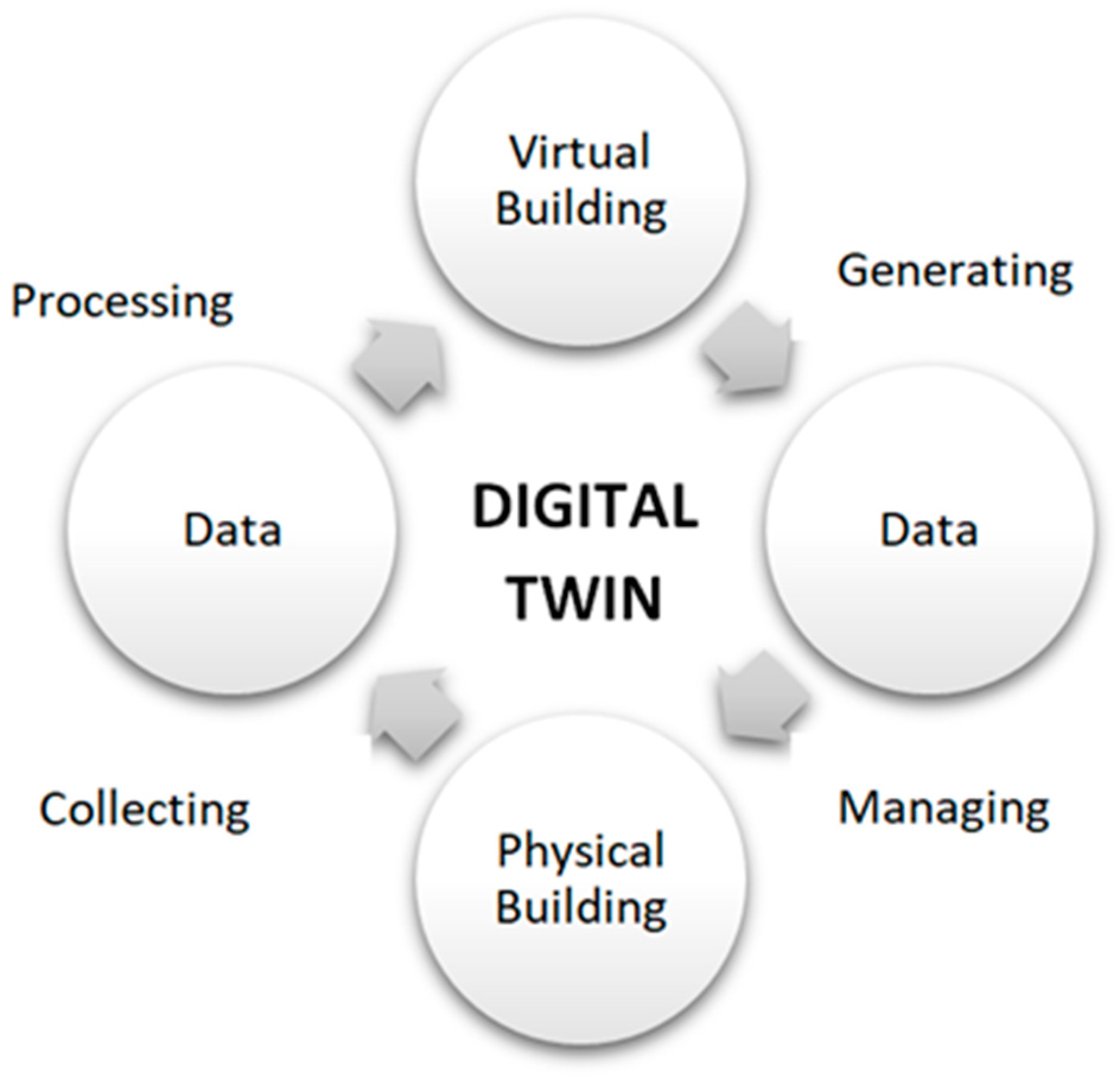
| Pollution | Stage of Creation | Impact on Human Health |
|---|---|---|
| Sulfur dioxide—SO2 | Emitted during fuel combustion, it creates sulfuric acid in the atmosphere in reactions | It can exacerbate asthma symptoms, limit airway and lung function, and cause headaches and general malaise. |
| Nitrogen oxides—NOx | Emitted directly during combustion, they form nitric acids in the atmosphere through reactions | It may have a negative effect on the liver and lungs, exacerbate the symptoms of respiratory infections and increase susceptibility to respiratory infections. |
| Fine dust—PM2.5, PM10 | Primary—emitted in the combustion process of hydrocarbon fuels and secondary | It may cause an increase in the incidence of respiratory and circulatory diseases, arrhythmia; it may cause asthma attacks, chronic cough |
| Non-metal volatile organic compounds—NMVOC | A very large group of organic compounds that play an important role in the formation of ozone (photochemical) smog | Reduced life expectancy due to short- and long-term exposure, increased risk of cancer, osteoporosis, kidney dysfunction |
| Ozone—O3 | It is produced in the atmosphere by reactions of NOx and other pollutants, including NMVOC, in the presence of sunlight | It has a negative impact on the respiratory system and may worsen asthma symptoms |
| Heavy metals—Hg, As, Cd, Ni, Pb | Natural components of coal emitted during combustion | They can cause cancer, hereditary defects |
| Radioactive elements | Radiation risk from the migration of radioactive elements contained in coal during its use | They have a global impact on premature mortality and morbidity in humans and have a carcinogenic effect |
| Criteria | Central Systems | Local Systems |
|---|---|---|
| Special requirements | Special requirements | Special requirements |
| Special requirements | The main devices are located in a special room outside the cooling/heating zone. A heating/cooling medium distribution system is necessary | No additional room for devices. Devices can be installed directly in the cooled/heated space and on the roof, on the casing or next to the building |
| Application | New buildings | New, existing, termodernized buildings |
| Investment cost | High investment cost | Affordable investment costs |
| Operating cost | Energy-efficient main appliances | Less energy-efficient appliances |
| Conservation | Easy access to the main equipment, located in one separate room | Difficult access to equipment that is installed in different parts of the building |
| Reliability | Long life of equipment. Possibility of installing main backup equipment | Reliable system, but estimated lifespan of equipment is shorter. Possibility to install more devices in different localizations |
Disclaimer/Publisher’s Note: The statements, opinions and data contained in all publications are solely those of the individual author(s) and contributor(s) and not of MDPI and/or the editor(s). MDPI and/or the editor(s) disclaim responsibility for any injury to people or property resulting from any ideas, methods, instructions or products referred to in the content. |
© 2024 by the authors. Licensee MDPI, Basel, Switzerland. This article is an open access article distributed under the terms and conditions of the Creative Commons Attribution (CC BY) license (https://creativecommons.org/licenses/by/4.0/).
Share and Cite
Babiarz, B.; Krawczyk, D.A.; Siuta-Olcha, A.; Manuel, C.D.; Jaworski, A.; Barnat, E.; Cholewa, T.; Sadowska, B.; Bocian, M.; Gnieciak, M.; et al. Energy Efficiency in Buildings: Toward Climate Neutrality. Energies 2024, 17, 4680. https://doi.org/10.3390/en17184680
Babiarz B, Krawczyk DA, Siuta-Olcha A, Manuel CD, Jaworski A, Barnat E, Cholewa T, Sadowska B, Bocian M, Gnieciak M, et al. Energy Efficiency in Buildings: Toward Climate Neutrality. Energies. 2024; 17(18):4680. https://doi.org/10.3390/en17184680
Chicago/Turabian StyleBabiarz, Bożena, Dorota Anna Krawczyk, Alicja Siuta-Olcha, Candida Duarte Manuel, Artur Jaworski, Ewelina Barnat, Tomasz Cholewa, Beata Sadowska, Martyna Bocian, Maciej Gnieciak, and et al. 2024. "Energy Efficiency in Buildings: Toward Climate Neutrality" Energies 17, no. 18: 4680. https://doi.org/10.3390/en17184680












